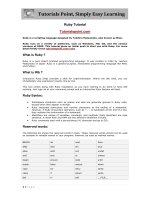perl tutorial english ebook
Bạn đang xem bản rút gọn của tài liệu. Xem và tải ngay bản đầy đủ của tài liệu tại đây (2.05 MB, 193 trang )
Perl Tutorial
i
PERL
Simply Easy Learning by tutorialspoint.com
tutorialspoint.com
TUTORIALS POINT
Simply Easy Learning
ABOUT THE TUTORIAL
Perl Tutorial
Perl is a programming language developed by Larry Wall, especially designed for text processing. It
stands for Practical Extraction and Report Language. It runs on a variety of platforms, such as Windows,
Mac OS, and the various versions of UNIX.
If you have basic knowledge of C or UNIX Shell then PERL is very easy to learn. This tutorial gives a
complete understanding on Perl.
Audience
This reference has been prepared for the beginners to help them understand the basic to advanced
concepts related to Perl Scripting languages.
Prerequisites
Before you start doing practice with various types of examples given in this reference, I'm making an
assumption that you are already aware about what is a computer program and what is a computer
programming language.
Copyright & Disclaimer Notice
All the content and graphics on this tutorial are the property of tutorialspoint.com. Any content from
tutorialspoint.com or this tutorial may not be redistributed or reproduced in any way, shape, or form
without the written permission of tutorialspoint.com. Failure to do so is a violation of copyright laws.
This tutorial may contain inaccuracies or errors and tutorialspoint provides no guarantee regarding the
accuracy of the site or its contents including this tutorial. If you discover that the tutorialspoint.com site
or this tutorial content contains some errors, please contact us at
TUTORIALS POINT
Simply Easy Learning
Table of Content
Perl Tutorial 2
Audience 2
Prerequisites 2
Copyright & Disclaimer Notice 2
Perl Introduction 12
What is PERL? 12
PERL Features 12
PERL and the Web 13
Perl is Interpreted 13
Perl Environment Setup 14
Getting Perl Installation 15
Install Perl: 15
Unix & Linux Installation 15
Windows Installation: 16
Macintosh Installation 16
Running Perl 16
(1) INTERACTIVE INTERPRETER: 16
(2) SCRIPT FROM THE COMMAND-LINE: 17
(3) INTEGRATED DEVELOPMENT ENVIRONMENT 17
Perl Syntax Overview 18
First Perl Program 18
INTERACTIVE MODE PROGRAMMING: 18
SCRIPT MODE PROGRAMMING 18
Perl File Extension 19
Comments in Perl 19
Whitespaces in Perl 19
Single & Double Quotes in Perl 20
"Here" Documents 20
Escaping Characters 21
Perl Identifiers: 21
Perl Data Types 22
Numeric Literals 22
String Literals 23
Example 24
Perl Variables 25
Creating Variables 25
Scalar Variables 26
TUTORIALS POINT
Simply Easy Learning
Array Variables 26
Hash Variables 26
Variable Context 27
Perl Scalars 28
Numeric Scalars 28
String Scalars 29
Scalar Operations 29
Multiline Strings 30
V-Strings 30
Special Literals 31
Perl Arrays 32
Array Creation 32
Accessing Array Elements 33
Sequential Number Arrays 33
Array Size 34
Adding and Removing Elements in Array 34
Slicing Array Elements 35
Replacing Array Elements 36
Transform Strings to Arrays 36
Transform Arrays to Strings 37
Sorting Arrays 37
The $[ Special Variable 38
Merging Arrays 38
Selecting Elements from Lists 39
Perl Hashes 40
Creating Hashes 40
Accessing Hash Elements 41
Extracting Slices 41
Extracting Keys and Values 41
Checking for Existence 42
Getting Hash Size 43
Add & Remove Elements in Hashes 43
Perl Conditional Statements 44
if statement 45
Syntax: 45
Flow Diagram: 46
Example: 46
if…else statement 47
Syntax: 47
TUTORIALS POINT
Simply Easy Learning
Flow Diagram: 47
Example: 47
if…elseif…else statement 48
Syntax: 48
Example: 48
unless statement 49
Syntax: 49
Flow Diagram: 50
Example: 50
unless…else statement 51
Syntax: 51
Flow Diagram: 51
Example: 51
unless…elseif…else statement 52
Syntax: 52
Example: 52
switch statement 53
Syntax: 53
Flow Diagram: 54
Example: 54
The ? : Operator 56
Perl Loops 57
while loop 58
Syntax: 58
Flow Diagram: 59
Example: 59
until loop 60
Syntax: 60
Flow Diagram: 60
Example: 61
for loop 61
Syntax: 61
Flow Diagram: 62
Example: 62
foreach loop 63
Syntax: 63
Flow Diagram: 63
Example: 63
do…while loop 64
TUTORIALS POINT
Simply Easy Learning
Syntax: 64
Flow Diagram: 64
Example: 65
nested loops 65
Syntax: 65
Example: 66
Loop Control Statements: 67
next statement 67
Syntax: 67
Flow Diagram: 68
Example 68
last statement 69
Syntax: 69
Flow Diagram: 70
Example - 1: 70
Example - 2: 70
continue statement 71
Syntax: 71
Example: 72
redo statement 72
Syntax: 72
Flow Diagram: 73
Example: 73
goto statement 73
Syntax: 74
Flow Diagram: 74
Example: 74
The Infinite Loop: 75
Perl Operators 76
Perl Arithmetic Operators: 76
Example 77
Perl Equality Operators: 77
Example 79
Perl Assignment Operators: 80
Example 82
Perl Bitwise Operators: 82
Example 83
Perl Logical Operators: 84
Example 85
TUTORIALS POINT
Simply Easy Learning
Quote-like Operators: 85
Example 85
Miscellaneous Operators: 86
Example 86
Perl Operators Precedence 87
Example 88
Perl Date and Time 89
Current Date & Time 89
GMT Time 90
Format Date & Time: 90
Epoch time 90
POSIX Function strftime() 91
Perl Subroutines 93
Define & Call a Subroutine: 93
PASSING ARGUMENTS TO A SUBROUTINE: 94
PASSING LISTS TO SUBROUTINES 94
PASSING HASHES TO SUBROUTINES 95
RETURNING VALUE FROM A SUBROUTINE: 95
PRIVATE VARIABLES IN A SUBROUTINE: 96
TEMPORARY VALUES VIA LOCAL() 96
STATE VARIABLES VIA STATE() 97
SUBROUTINE CALL CONTEXT 97
Perl References 99
Create References: 99
Dereferencing: 99
Circular References 101
References to Functions 101
Perl Formats 102
Define a Format 102
Using the Format 103
Define a Report Header 104
Define a Pagination 105
Number of Lines on a Page 105
Define a Report Footer 105
Perl File I/O 106
Opening and Closing Files 106
Open Function 106
Sysopen Function 107
Close Function 108
TUTORIALS POINT
Simply Easy Learning
Reading and Writing Files 108
The <FILEHANDLE> Operator 108
getc Function 109
read Function 109
print Function 109
Copying Files 109
Renaming a file 110
Deleting an exiting file 110
Positioning inside a file 110
TELL FUNCTION 110
SEEK FUNCTION 110
File Information 110
Perl Directories 113
Display all the files 113
Create new directory 114
Remove a directory 114
Change a directory 114
Error Handling 116
The if statement 116
The unless function 116
The ternary operator 117
The warn function 117
The die function 117
Errors within modules 117
The carp function 118
The cluck function 118
The croak Function 119
The confess function 119
Perl Special Variables 121
Special variable types 122
Global Scalar Special Variables 122
Global Array Special Variables 124
Global Hash Special Variables 125
Global Special Filehandles 125
Global Special Constants 125
Regular Expression Special Variables 126
Filehandle Special Variables 126
Perl Coding Standard 128
Perl Regular Expressions 131
TUTORIALS POINT
Simply Easy Learning
The Match Operator 131
Match Operator Modifiers 132
Matching Only Once 133
Regular Expression Variables 133
The Substitution Operator 133
Substitution Operator Modifiers 134
The Translation Operator 134
Translation Operator Modifiers 135
More complex regular expressions 135
Matching Boundaries 137
Selecting Alternatives 137
Grouping Matching 137
The \G Assertion 138
Regular-expression Examples 139
Literal characters: 139
Character classes: 139
Special Character Classes: 139
Repetition Cases: 139
Nongreedy repetition: 140
Grouping with parentheses: 140
Backreferences: 140
Alternatives: 140
Anchors: 140
Special syntax with parentheses: 141
Perl Sending Email 142
Perl Socket Programming 146
To create a server 146
To create a client 146
Server Side Socket Calls 147
THE SOCKET() CALL 147
THE BIND() CALL 147
THE LISTEN() CALL 148
THE ACCEPT() CALL 148
Client Side Socket Calls 149
THE CONNECT() CALL 149
Client - Server Example 149
SCRIPT TO CREATE A SERVER 149
SCRIPT TO CREATE A CLIENT 150
Object Oriented Programming in Perl 151
TUTORIALS POINT
Simply Easy Learning
Object Basics 151
Defining a Class 151
Creating and Using Objects 152
Defining Methods 152
Inheritance 154
Method Overriding 155
Default Autoloading 156
Destructors and Garbage Collection 157
Object Oriented Perl Example 157
Perl Database Access 160
Architecture of a DBI Application 160
Notation and Conventions 160
Database Connection 161
INSERT Operation 161
Using Bind Values 162
READ Operation 162
Using Bind Values 163
UPDATE Operation 163
Using Bind Values 163
DELETE Operation 164
Using do Statement 164
COMMIT Operation 164
ROLLBACK Operation 164
Begin Transaction 165
AutoCommit Option 165
Automatic Error Handling 165
Disconnecting Database 165
Using NULL values 165
Some other DBI functions 166
available_drivers 166
installed_drivers 166
data_sources 166
quote 166
Methods Common to all Handles 167
err 167
errstr 167
rows 167
trace 167
Interpolated Statements are Prohebited 168
TUTORIALS POINT
Simply Easy Learning
Perl CGI Programming 169
Web Browsing 169
CGI Architecture Diagram 170
Web Server Support & Configuration 170
First CGI Program 170
Hello Word! This is my first CGI program 171
Understanding HTTP Header 171
CGI Environment Variables 171
Raise a "File Download" Dialog Box ? 172
GET and POST Methods 173
Passing Information using GET method: 173
Simple URL Example : Get Method 173
Simple FORM Example: GET Method 174
Passing Information using POST method: 174
Passing Checkbox Data to CGI Program 175
Passing Radio Button Data to CGI Program 176
Passing Text Area Data to CGI Program 177
Passing Drop Down Box Data to CGI Program 178
Using Cookies in CGI 179
How It Works 179
Setting up Cookies 179
Retrieving Cookies 180
CGI Modules and Libraries 180
Perl Packages and Modules 181
What are Perl Modules? 182
The Require Function 183
The Use Function 183
Create the Perl Module Tree 184
Installing Perl Module 184
Perl Process Management 186
Backstick Operator 186
The system() Function 187
The fork() Function 187
The kill() Function 189
Perl Embedded Documentation 190
What is POD? 191
POD Examples 192
Copyright 2005 [TUTORIALSOPOINT]. 192
An Example List 192
TUTORIALS POINT
Simply Easy Learning
Perl Introduction
P
erl is a general-purpose programming language originally developed for text manipulation and now used
for a wide range of tasks including system administration, web development, network programming, GUI
development, and more.
What is PERL?
Perl is a stable, cross platform programming language.
Perl stands for Practical Extraction and Report Language.
It is used for mission critical projects in the public and private sectors.
Perl is an Open Source software, licensed under its Artistic License, or the GNU General Public License
(GPL).
Perl was created by Larry Wall.
Perl 1.0 was released to usenet's alt.comp.sources in 1987
At the time of writing thi tutorial, latest version of perl is 5.16.2
Perl is listed in the Oxford English Dictionary.
PC Magazine named Perl a finalist for its 1998 Technical Excellence Award in the Development Tool category.
PERL Features
Perl takes the best features from other languages, such as C, awk, sed, sh, and BASIC, among others.
Perls database integration interface DBI supports third-party databases including Oracle, Sybase, Postgres,
MySQL and others.
Perl works with HTML, XML, and other mark-up languages.
Perl supports Unicode.
CHAPTER
1
TUTORIALS POINT
Simply Easy Learning
Perl is Y2K compliant.
Perl supports both procedural and object-oriented programming.
Perl interfaces with external C/C++ libraries through XS or SWIG.
Perl is extensible. There are over 500 third party modules available from the Comprehensive Perl Archive
Network (CPAN).
The Perl interpreter can be embedded into other systems.
PERL and the Web
Perl is the most popular web programming language due to its text manipulation capabilities and rapid
development cycle.
Perl is widely known as " the duct-tape of the Internet".
Perl's CGI.pm module, part of Perl's standard distribution, makes handling HTML forms simple.
Perl can handle encrypted Web data, including e-commerce transactions.
Perl can be embedded into web servers to speed up processing by as much as 2000%.
Perl's mod_perl allows the Apache web server to embed a Perl interpreter.
Perl's DBI package makes web-database integration easy.
Perl is Interpreted
Perl is an interpreted, which means that your code can be run as is, without a compilation stage that creates a
non portable executable program.
Traditional compilers convert programs into machine language. When you run a Perl program, it's first compiled
into a byte code, which is then converted ( as the program runs) into machine instructions. So it is not quite the
same as shells, or Tcl, which are strictly interpreted without an intermediate representation.
Neither it is like most versions of C or C++, which are compiled directly into a machine dependent format. It is
somewhere in between, along with Python and awk and Emacs .elc files.
TUTORIALS POINT
Simply Easy Learning
Perl Environment Setup
B
efore we start writing our Perl programs, let's understand how to setup our Perl environment. Perl is
available on a wide variety of platforms:
Unix (Solaris, Linux, FreeBSD, AIX, HP/UX, SunOS, IRIX etc.)
Win 9x/NT/2000/
WinCE
Macintosh (PPC, 68K)
Solaris (x86, SPARC)
OpenVMS
Alpha (7.2 and later)
Symbian
Debian GNU/kFreeBSD
MirOS BSD
And many more
This is more likely that your system will have perl installed on it. Just try giving following command at the $ prompt:
$perl -v
If you have perl installed on your machine then you will get a message something as follows:
This is perl 5, version 16, subversion 2 (v5.16.2) built for i686-linux
Copyright 1987-2012, Larry Wal
Perl may be copied only under the terms of either the Artistic License or the
GNU General Public License, which may be found in the Perl 5 source kit.
CHAPTER
2
TUTORIALS POINT
Simply Easy Learning
Complete documentation for Perl, including FAQ lists, should be found on
this system using "man perl" or "perldoc perl". If you have access to the
Internet, point your browser at the Perl Home Page.
If you do not have perl already installed then proceed to the next section.
Getting Perl Installation
The most up-to-date and current source code, binaries, documentation, news, etc. is available at the official
website of Perl:
Perl Official Website :
You can download Perl documentation from the following site.
Perl Documentation Website :
Install Perl:
Perl distribution is available for a wide variety of platforms. You need to download only the binary code
applicable for your platform and install Perl.
If the binary code for your platform is not available, you need a C compiler to compile the source code
manually. Compiling the source code offers more flexibility in terms of choice of features that you
require in your installation.
Here is a quick overview of installing Perl on various platforms:
Unix & Linux Installation
Here are the simple steps to install Perl on Unix/Linux machine.
Open a Web browser and go to
Follow the link to download zipped source code available for Unix/Linux.
Download perl-5.x.y.tar.gz file and issue the following commands at $ prompt.
$tar -xzf perl-5.x.y.tar.gz
$cd perl-5.x.y
$./Configure -de
$make
$make test
$make install
NOTE: Here $ is Unix prompt where you type your command, so make sure you are not typing $ while typing
above mentioned commands.
This will install Perl in a standard location /usr/local/bin and its libraries are installed in/usr/local/lib/perlXX where
XX is the version of Perl that you are using.
It will take a while to compile the source code after issuing make command. Once installation is done, you can
issue perl -v command at $ prompt to check perl installation. If everything is fine then it will display message like I
have shown above.
TUTORIALS POINT
Simply Easy Learning
Windows Installation:
Here are the steps to install Perl on Windows machine.
Follow the link for the Strawberry Perl installation on Windows
Download either 32bit or 64bit version of installation.
Run the downloaded file by double-clicking it in Windows Explorer. This brings up the Perl install wizard,
which is really easy to use. Just accept the default settings, wait until the install is finished, and you're ready
to roll!
Macintosh Installation
In order to build your own version of Perl you will need 'make' this is part of the Apples developer tools usually
supplied with Mac OS install DVDs. You do not need the latest version of Xcode (which is now charged for) in
order to install make.
Here are the simple steps to install Perl on Mac OS X machine.
Open a Web browser and go to
Follow the link to download zipped source code available for Mac OS X.
Download perl-5.x.y.tar.gz file and issue the following commands at $ prompt.
$tar -xzf perl-5.x.y.tar.gz
$cd perl-5.x.y
$./Configure -de
$make
$make test
$make install
This will install Perl in a standard location /usr/local/bin and its libraries are installed in/usr/local/lib/perlXX where
XX is the version of Perl that you are using.
Running Perl
There are following different ways to start Perl:
(1) INTERACTIVE INTERPRETER:
You can enter perl and start coding right away in the interactive interpreter by starting it from the command line.
You can do this from Unix, DOS, or any other system which provides you a command-line interpreter or shell
window.
$perl -e <perl code> # Unix/Linux
or
C:>perl -e <perl code> # Windows/DOS
Here is the list of all the available command line options:
TUTORIALS POINT
Simply Easy Learning
Option
Description
-d[:debugger]
Run program under debugger
-Idirectory
Specify @INC/#include directory
-T
Enable tainting checks
-t
Enable tainting warnings
-U
Allow unsafe operations
-w
Enable many useful warnings
-W
Enable all warnings
-X
Disable all warnings
-e program
run Perl script sent in as program
file
run Perl script from a given file
(2) SCRIPT FROM THE COMMAND-LINE:
A Perl script is a text file which keeps perl code in it and it can be executed at command line by invoking the
interpreter on your application, as in the following:
$perl script.pl # Unix/Linux
or
C:>perl script.pl # Windows/DOS
(3) INTEGRATED DEVELOPMENT ENVIRONMENT
You can run Perl from a graphical user interface (GUI) environment as well. All you need is a GUI application on
your system that supports Perl. You can download Padre, the Perl IDE. You can also use Eclipse Plugin EPIC -
Perl Editor and IDE for Eclipse if you are familiar with Eclipse.
Before proceeding to next chapter, make sure your environment is properly setup and working perfectly fine. If you
are not able to setup the environment properly then you can take help from your system admininstrator.
Al the examples given in subsequent chapters have been executed with v5.16.2 version available on CentOS
flavor of Linux.
TUTORIALS POINT
Simply Easy Learning
Perl Syntax Overview
P
erl borrows syntax and concepts from many languages: awk, sed, C, Bourne Shell, Smalltalk, Lisp and
even English. However, there are some definite differences between the languages. This chapter is designed to
quickly get you up to speed on the syntax that is expected in Perl.
A Perl program consists of a sequence of declarations and statements which run from the top to the bottom.
Loops, subroutines, and other control structures allow you to jump around within the code. Every simple statement
must end with a semicolon (;).
Perl is a free-form language: you can format and indent it however you like. Whitespace serves mostly to separate
tokens, unlike languages like Python where it is an important part of the syntax, or Fortran where it is immaterial.
First Perl Program
INTERACTIVE MODE PROGRAMMING:
You can use Perl interpreter with -e option at command line which lets you execute Perl statements from the
command line. Let's try something at $ prompt as follows:
$perl -e 'print "Hello World\n"'
This execution will produce following result:
Hello, world
SCRIPT MODE PROGRAMMING
Assuming you are already on $ prompt. So let's open a text file hello.pl using vi or vim editor and put the following
lines inside your file.
#!/usr/bin/perl
# This will print "Hello, World"
print "Hello, world\n";
Here /usr/bin/perl is actual perl interpreter binary. Before you execute your script be sure to change the mode of
the script file and give execution priviledge, generally a setting of 0755 works perfectly and finally and finally you
execute above script as follows:
$chmod 0755 hello.pl
CHAPTER
3
TUTORIALS POINT
Simply Easy Learning
$./hello.pl
This execution will produce following result:
Hello, world
You can use parentheses for functions arguments or omit them according to your personal taste. They are only
required occasionally to clarify issues of precedence. Following two statements produce same result.
print("Hello, world\n");
print "Hello, world\n";
Perl File Extension
A Perl script can be created inside of any normal simple-text editor program. There are several programs available
for every type of platform. There are many programs designed for programmers available for download on the web.
Regardless of the program you choose to use, a Perl file must be saved with a .pl or .PL file extension in order to
be recognized as a functioning Perl script. File names can contain numbers, symbols, and letters but must not
contain a space. Use an underscore (_) in places of spaces.
Comments in Perl
Comments in any programming language are friends of developers. Comments can be used to make program user
friendly and they are simply skipped by the interpreter without impacting code functionality. For example, in the
above program a line starting with hash # is a comment.
Simply saying comments in Perl start with a hash symbol and run to the end of the line:
# This is a comment in perl
Lines starting with = are interpreted as the start of a section of embedded documentation (pod), and all
subsequent lines until the next =cut are ignored by the compiler. Following is the example:
#!/usr/bin/perl
# This is a single line comment
print "Hello, world\n";
=begin comment
This is all part of multiline comment.
You can use as many lines as you like
These comments will be ignored by the
compiler until the next =cut is encountered.
=cut
This will produce following result:
Hello, world
Whitespaces in Perl
A Perl program does not care about whitespaces. Following program works perfectly fine:
TUTORIALS POINT
Simply Easy Learning
#!/usr/bin/perl
print "Hello, world\n";
But if spaces are inside the quoted strings then they would be printed as is. For example:
#!/usr/bin/perl
# This would print with a line break in the middle
print "Hello
world\n";
This will produce following result:
Hello
world
All types of whitespace like spaces, tabs, newlines, etc. are equivalent for the interpreter when they are used
outside of the quotes. A line containing only whitespace, possibly with a comment, is known as a blank line, and
Perl totally ignores it.
Single & Double Quotes in Perl
You can use double quotes or single quotes around literal strings as follows:
#!/usr/bin/perl
print "Hello, world\n";
print 'Hello, world\n';
This will produce following result:
Hello, world
Hello, world\n$
There is important different in single and double quotes. Only double quotes interpolate variables and special
characters such as newlines \n where as single quote does not interpolate any variable or special character. Check
below example where we are using $a as a variable to store a value and later printing that value:
#!/usr/bin/perl
$a = 10;
print "Value of a = $a\n";
print 'Value of a = $a\n';
This will produce following result:
Value of a = 10
Value of a = $a\n$
"Here" Documents
You can store or print multiline text with a great comfort. Even you can make use of variables inside "here"
document. Below is a simple syntax, check carefully there must be no space between the << and the identifier.
An identifier may be either a bare word or some quoted text like we used EOF below. If identifier is quoted, the
type of quote you use determines the treatment of the text inside the here docoment, just as in regular quoting.
An unquoted identifier works like double quotes.
TUTORIALS POINT
Simply Easy Learning
#!/usr/bin/perl
$a = 10;
$var = <<"EOF";
This is the syntax for here document and it will continue
until it encounters a EOF in the first line.
This is case of double quote so variable value will be
interpolated. For example value of a = $a
EOF
print "$var\n";
$var = <<'EOF';
This is case of single quote so variable value will be
interpolated. For example value of a = $a
EOF
print "$var\n";
This will produce following result:
This is the syntax for here document and it will continue
until it encounters a EOF in the first line.
This is case of double quote so variable value will be
interpolated. For example value of a = 10
This is case of single quote so variable value will be
interpolated. For example value of a = $a
Escaping Characters
Perl uses the backslash (\) character to escape any type of character that might interfere with our code. Let's take
one example where we want to print double quote and $ sign:
#!/usr/bin/perl
$result = "This is \"number\"";
print "$result\n";
print "\$result\n";
This will produce following result:
This is "number"
$result
Perl Identifiers:
A Perl identifier is a name used to identify a variable, function, class, module, or other object. A Perl variable
name starts with either $, @ or % followed by zero or more letters, underscores, and digits (0 to 9).
Perl does not allow punctuation characters such as @, $, and % within identifiers. Perl is a case
sensitive programming language. Thus $Manpower and $manpower are two different identifiers in Perl.
TUTORIALS POINT
Simply Easy Learning
Perl Data Types
P
erl is loosely typed language and there is no need to specify a type for your data while using in your
program. The Perl interpreter will choose the type based on the context of the data itself.
Perl has three basic data types: scalars, arrays of scalars, and hashes of scalars, also known as associative
arrays. Here is little detail about these data types.
S.N.
Types and Description
1
Scalar:
Scalars are simple variables. They are preceded by a dollar sign ($). A scalar is either a number, a string,
or a reference. A reference is actually an address of a variable which we will see in upcoming chapters.
2
Arrays:
Arrays are ordered lists of scalars that you access with a numeric index which starts with 0. They are
preceded by an "at" sign (@).
3
Hashes:
Hashes are unordered sets of key/value pairs that you access using the keys as subscripts. They are
preceded by a percent sign (%).
Numeric Literals
Perl stores all the numbers internally as either signed integers or double-precision floating-point values. Numeric
literals are specified in any of the following floating-point or integer formats:
Type
Value
Integer
1234
Negative integer
-100
Floating point
2000
Scientific notation
16.12E14
CHAPTER
4
TUTORIALS POINT
Simply Easy Learning
Hexadecimal
0xffff
Octal
0577
String Literals
Strings are sequences of characters. They are usually alphanumeric values delimited by either single (') or double
(") quotes. They work much like UNIX shell quotes where you can use single quoted strings and double quoted
strings.
Double-quoted string literals allows variable interpolation, and single-quoted strings are not. There are certain
characters when they are proceeded by a back slash they will have special meaning and they are used to
represent like newline (\n) or tab (\t).
You can embed newlines or any of the following Escape sequences directly in your double quoted strings:
Escape sequence
Meaning
\\
Backslash
\'
Single quote
\"
Double quote
\a
Alert or bell
\b
Backspace
\f
Form feed
\n
Newline
\r
Carriage return
\t
Horizontal tab
\v
Vertical tab
\0nn
Creates Octal formatted numbers
\xnn
Creates Hexideciamal formatted numbers
\cX
Control characters, x may be any character
\u
Force next character to uppercase
\l
Force next character to lowercase
\U
Force all following characters to uppercase
TUTORIALS POINT
Simply Easy Learning
\L
Force all following characters to lowercase
\Q
Backslash all following non-alphanumeric characters
\E
End \U, \L, or \Q
Example
Let's see again how strings behaves with single quotation and double quotation. Here we will use string escapes
mentioned in the above table and will make use of scalar variable to assign string values.
#!/usr/bin/perl
# This is case of interpolation.
$str = "Welcome to \ntutorialspoint.com!";
print "$str\n";
# This is case of non-interpolation.
$str = 'Welcome to \ntutorialspoint.com!';
print "$str\n";
# Only W will become upper case.
$str = "\uwelcome to tutorialspoint.com!";
print "$str\n";
# Whole line will become capital.
$str = "\UWelcome to tutorialspoint.com!";
print "$str\n";
# A portion of line will become capital.
$str = "Welcome to \Ututorialspoint\E.com!";
print "$str\n";
# Backsalash non alpha-numeric including spaces.
$str = "\QWelcome to tutorialspoint's family";
print "$str\n";
This will produce following result:
Welcome to
tutorialspoint.com!
Welcome to \ntutorialspoint.com!
Welcome to tutorialspoint.com!
WELCOME TO TUTORIALSPOINT.COM!
Welcome to TUTORIALSPOINT.com!
Welcome\ to\ tutorialspoint\'s\ family









